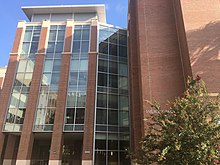Emerging Pathogens Institute
This article contains promotional content. (February 2023) |
 The Emerging Pathogen Research Facility | |
| Established | 2007 |
|---|---|
| Director | J. Glenn Morris |
| Location | , |
| Website | Official website |
The Emerging Pathogens Institute (EPI) is an interdisciplinary research institution associated with the University of Florida. The institute focuses on fusing key disciplines to develop outreach, education, and research capabilities designed to preserve the region's health and economy, as well as to prevent or contain new and re-emerging diseases.[1] Researchers within the institute work in more than 30 different countries around the world, with over 250 affiliated faculty members stemming from 11 University of Florida colleges, centers, and institutes. The 90,000-square-foot building includes laboratories and collaborative space for bioinformatics and mathematical modeling.
History
[edit]The idea of this institute was first created by the University of Florida faculty and researchers, prompted by the recognition of a need for a facility that could drive pathogen-related research in FlorUida. Funding for the EPI was provided by the Florida State Legislature in 2006. In 2007, Dr. J. Glenn Morris was recruited from the University of Maryland, Baltimore to serve as the founding director of the EPI. Construction on a new, dedicated 90,000-square-foot research facility was completed in 2009. The structure houses the institute and numerous top researchers, as well as the Southeastern National Tuberculosis Center (SNTC), the Southern HIV and Alcohol Research Consortium (SHARC) and one of the CDC Centers of Excellence in Vector-borne Diseases.[2]
In March 2009, the institute received a substantial grant from the Bill and Melinda Gates Foundation. This was the first time that the University of Florida has ever received direct funding from this foundation, and the grant was provided to help researchers develop tools to fight malaria.[3]
Major areas of research
[edit]- Vector-Borne Diseases
- Viral respiratory pathogens
- Tuberculosis
- Drug-resistant Tuberculosis
- Non-Tuberculosis Mycobacterial Disease
- Enteric and Foodborne Illnesses
- Plant Pathogens
- Antibiotic Resistance/Hospital Infection Control
- HIV
- Zoonoses
Global research
[edit]The Emerging Pathogens Institute channels multidisciplinary programs focused on plant, human and animal pathogens, including viral discovery, vector-borne pathogens and, most recently, coronaviruses and pandemic preparedness. Publications include papers in top scientific journals, including Science, Nature and Proceedings of the National Academy of Sciences. Given the speed with which pathogens can move globally, work in the EPI has had a strong international focus, with collaborations in place with investigators in over 50 countries.
EPI investigators have been involved in research on various coronavirus species for a number of years. With the onset of the pandemic, the EPI has played a role in population-based studies of COVID-19, including studies of transmission within schools.[4] Other areas of research have included development of mathematical models predicting spread of the virus in Florida in successive pandemic waves,[5] the critical role of aerosols in transmission of the virus[6][7][8] and the transmission of coronaviruses of animal origin into humans.[9][10]
Directors
[edit]2007–Present J. Glenn Morris
See also
[edit]- University of Florida
- Buildings at the University of Florida
- Infectious Disease Pharmacokinetics Laboratory
References
[edit]- ^ "Emerging Pathogens Institute - University of Florida". epi.ufl.edu.
- ^ "Florida breaks ground for pathogen research lab - DVM Newsmagazine | HighBeam Research". October 22, 2012. Archived from the original on 2012-10-22.
- ^ Crabbe N. "Gates Foundation gives grant to UF". Gainesville Sun.
- ^ Nelson EJ, McKune SL, Ryan KA, Shapiro J, Mott-Young AH, Myers PD, Morris JG (March 2022). "Antigen vs RT-PCR Tests for Screening Quarantined Students in Florida During the COVID-19 Pandemic SARS-CoV-2 Delta Variant Surge". JAMA Pediatrics. 176 (5): 525–526. doi:10.1001/jamapediatrics.2022.0080. PMC 8902689. PMID 35254393.
- ^ Hladish TJ, Pillai AN, Longini IM (January 2022). "Updated projections for COVID-19 omicron wave in Florida". medRxiv 10.1101/2022.01.06.22268849.
- ^ Lednicky JA, Shankar SN, Elbadry MA, Gibson JC, Alam MM, Stephenson CJ, et al. (June 2020). "Collection of SARS-CoV-2 Virus from the Air of a Clinic Within a University Student Health Care Center and Analyses of the Viral Genomic Sequence". Aerosol and Air Quality Research. 20 (6): 1167–1171. doi:10.4209/aaqr.2020.05.0202. PMC 7792982. PMID 33424954.
- ^ Lednicky JA, Lauzard M, Fan ZH, Jutla A, Tilly TB, Gangwar M, et al. (November 2020). "Viable SARS-CoV-2 in the air of a hospital room with COVID-19 patients". International Journal of Infectious Diseases. 100: 476–482. doi:10.1016/j.ijid.2020.09.025. PMC 7493737. PMID 32949774.
- ^ Lednicky JA, Lauzardo M, Alam MM, Elbadry MA, Stephenson CJ, Gibson JC, Morris JG (July 2021). "Isolation of SARS-CoV-2 from the air in a car driven by a COVID patient with mild illness". International Journal of Infectious Diseases. 108: 212–216. doi:10.1016/j.ijid.2021.04.063. PMC 8064821. PMID 33901650.
- ^ Lednicky JA, Tagliamonte MS, White SK, Elbadry MA, Alam MM, Stephenson CJ, et al. (December 2021). "Independent infections of porcine deltacoronavirus among Haitian children". Nature. 600 (7887): 133–137. Bibcode:2021Natur.600..133L. doi:10.1038/s41586-021-04111-z. PMC 8636265. PMID 34789872.
- ^ Lednicky JA, Tagliamonte MS, White SK, Blohm GM, Alam MM, Iovine NM, et al. (October 2021). "Isolation of a Novel Recombinant Canine Coronavirus from a Visitor to Haiti: Further Evidence of Transmission of Coronaviruses of Zoonotic Origin to Humans". Clinical Infectious Diseases. 75 (1): e1184 – e1187. doi:10.1093/cid/ciab924. PMC 9402678. PMID 34718467.


 French
French Deutsch
Deutsch